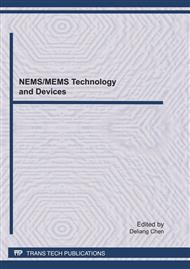[1]
M.Z. Bazant and B. Yuxing, Theoretical prediction of fast 3D AC electro-osmotic pumps. Lab on a Chip, 2006. 6(11): pp.1455-1461.
DOI: 10.1039/b608092h
Google Scholar
[2]
J.P. Urbanski, J.A. Levitan, D.N. Burch, T. Thorsen, and M.Z. Bazant, The effect of step height on the performance of three-dimensional ac electro-osmotic microfluidic pumps. Journal of colloid and interface science, 2007. 309(2): pp.332-341.
DOI: 10.1016/j.jcis.2007.01.095
Google Scholar
[3]
J.P. Urbanski, T. Thorsen, J.A. Levitan, and M.Z. Bazant, Fast ac electro-osmotic micropumps with nonplanar electrodes. Applied Physics Letters, 2006. 89(14): pp.143508-3.
DOI: 10.1063/1.2358823
Google Scholar
[4]
A. Ramos, H. Morgan, N.G. Green, and A. Castellanos, AC Electric-Field-Induced Fluid Flow in Microelectrodes. Journal of colloid and interface science, 1999. 217(2): pp.420-422.
DOI: 10.1006/jcis.1999.6346
Google Scholar
[5]
A. González, A. Ramos, N.G. Green, A. Castellanos, and H. Morgan, Fluid flow induced by nonuniform ac electric fields in electrolytes on microelectrodes. II. A linear double-layer analysis. Physical Review E, 2000. 61.
DOI: 10.1103/physreve.61.4019
Google Scholar
[6]
R.J. Hunter, Zeta Potential in Colloid Science: Principles and Applications. 1981, Academic Press: London. pp.1-58.
Google Scholar
[7]
N.G. Green, A. Ramos, A. Gonzalez, H. Morgan, and A. Castellanos, Fluid flow induced by nonuniform ac electric fields in electrolytes on microelectrodes. III. Observation of streamlines and numerical simulation. Physical Review E 66(2): p.026305/1-02630511.
DOI: 10.1103/physreve.66.026305
Google Scholar
[8]
M.Z. Bazant and T.M. Squires, Induced-Charge Electrokinetic Phenomena: Theory and Microfluidic Applications. Physical Review Letters, 2004. 92 9. V. Levich, Physicochemical Hydrodynamics. 1962, Prentice-Hall Inc.: NJ. pp.472-533.
DOI: 10.1103/physrevlett.92.066101
Google Scholar
[10]
H.A. Stone, A.D. Stroock, and A. Ajdari, Engineering flows in small devices: Microfluidics toward a lab-on-a-chip. Annual Review of Fluid Mechanics, 2004. 36: pp.381-411.
DOI: 10.1146/annurev.fluid.36.050802.122124
Google Scholar
[11]
K. Xie, Y. Lai, X. Guo, and R. Campbell, A three phase serpentine micro electrode array for AC electroosmotic flow pumping. Microsystem Technologies, 2010. 16(10): pp.1825-1830.
DOI: 10.1007/s00542-010-1106-9
Google Scholar
[12]
T. Hirono and et al., Microfluidic image cytometry for measuring number and sizes of biological cells flowing through a microchannel using the micro-PIV technique. Measurement Science and Technology, 2008. 19(2): p.025401.
DOI: 10.1088/0957-0233/19/2/025401
Google Scholar


